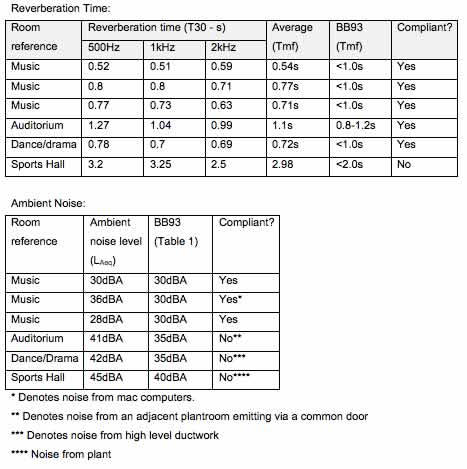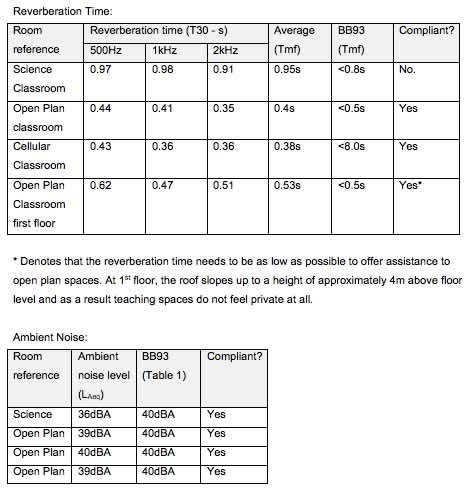Sound Test Acoustic Consultants Section 61 Vibration Testing
Pace Consult has been invited to project acoustic consultancy on a school project in the Cayman Islands. The background to the project is that two identical school designs were procured and following the completion of one of the schemes the second project was immediately shelved.
As part of our works on the project Pace Consult Managing Director, Martin Jones visited Grand Cayman and this brief discussion illustrates the analysis undertaken while on a visit to the completed school scheme. Also set out are the conclusions drawn as to why the 2nd project was shelved following completion of the first and the need to involve a new design team to rework and deliver the half-constructed project.

Measurements undertaken within the existing school are set out against the current UK guidance for School design BB93. Areas of acoustic conflict identified within the school are also discussed.
The teaching buildings visited are laid out as an open-plan learning environment, however, classes are taught in the traditional way, with the teacher addressing the pupils of a class of 25 students from a fixed position. This operational layout goes against the principles of open plan delivery. It is concluded that the initial designers of the two school projects, did not sufficiently engage (or chose not to) with the educators in the important background used to prepare the design. It is clear that the method of educational delivery does not suit the open plan and anecdotally there was never any intent to change this. It is simply the case that the facilities are at odds with how they were going to be operated. Had educationalists on the island had their voice heard, the initial design team would clearly have had to deliver a scheme that promoted a more cellular accommodation layout.
Our results are set out below with the reference criteria taken from BB93 2015.
The above teaching spaces were all within one building which for the main part, the teaching area is open plan. Class sizes are clearly between 20 and 25 pupils taught from a single teaching location in the traditional manner. Wide circulation routes around each side of each teaching area ensure that sound insulation is minimised.
As educational delivery is undertaken in a traditional manner, classes held in this way should be within cellularised accommodation. This would be designed under BB93 to achieve a minimum in-situ performance of 45dB DnT, w. Tests between class areas at the ground floor and first floor have yielded results of DnT, w 13dB and DnT, w 8dB, respectively. This is a very low level of sound insulation.
Open Plan Spaces Discussion: Association of Noise Consultants Guidance
The main issue is that intrusive noise arising from activities in adjacent learning areas and circulation spaces significantly increases the background noise level, which in turn decreases speech intelligibility and causes distraction. Occupants working and talking within the space tend to raise their vocal effort as the background noise level increases, resulting in a spiralling increase in noise levels, unless sound-absorbent finishes are provided.
Open-plan spaces are generally designed for high flexibility in terms of the layout of teaching and study areas. However, achieving maximum flexibility usually requires the provision of a mixture of both open and enclosed spaces to provide appropriate listening conditions for the diversity of learning activities and learners’ needs.
Open plan teaching and learning spaces call for the commitment of end-users to co-ordinate and manage activities in adjacent teaching and learning spaces and circulation areas, in order to control intrusive noise levels. Users of the space cannot reasonably expect to use open plan areas in the same way as cellular types of accommodation, whilst maintaining the same degree of privacy.
The suggestion of a move to open-plan teaching appears to have been only been realised at the point of completion of the school. This seems at odds with the normal pattern of stakeholder engagement that is seen in projects certainly in the UK. We naturally cannot comment on this decision-making process other than it seems to obviously clash with the method of educational delivery applied.
Subdivision of open-plan spaces: Association of Noise Consultants Guidance.
Folding walls and operable partitions are sometimes used to provide flexibility in teaching spaces or to divide open plan areas. A standard folding partition with no acoustic seals or detailing may provide a value as low as 25 dB Rw.

Whilst higher performance folding partitions are available that can provide up to 58 dB Rw, the sound insulation achievable on-site depends on very careful installation, with stringent control over flanking transmission, and effective acoustic sealing. The performance also deteriorates if seals or tracks become worn or damaged in use. As a result, it can be very difficult to achieve sound insulation values greater than 45 dB DnT,w.
It is important that the specification of folding partitions takes into account the weight, ease of opening and maintenance. Regular inspection and servicing will extend the life of a partition and ensure that it achieves the desired sound insulation. Folding partitions are useful in many applications, but they should only be used when necessary and not as a response to a non-specific aspiration for flexibility in the layout of teaching areas. The design team should be made aware that the use of the allowable exception in BB 93 for folding partitions may not provide acoustic conditions that permit simultaneous independent use of the adjacent rooms.
As can be seen from the guidance above, even though very basic movable walls are only capable of an in-situ sound insulation performance of 25dB, this remains double the ground floor sound insulation performance. In the case of the 1st floor, this value is triple the current performance. Therefore substantial improvements could potentially be made.
Generally speaking, open-plan teaching delivery can work, provided the following are incorporated into the lesson delivery method:
- Detailed instruction occurs in a plenary session in dedicated cellularised areas, therefore there is no need for the annunciative addressing of the class within the open plan space
- Project based learning through individual study and 1-on-1 sessions at quiet conversational noise levels only
- Reduced communication distance through 1-on-1/small group assistance
- Reduced message urgency
- More opportunity to repeat spoken message by moving between groups/individuals
- Reduced occurrence of speech, avoidance annunciative teaching
- Reduced need for continuous communication/address (e.g. individual work)






